1950s
Orienta
From the Wikipedia page:
The album's liner notes stated that the music "resembles the dreams of an imaginative person who has fallen asleep during a 'Dr. Fu Manchu' movie on television," with vignettes that "combine the sounds of the East with the wit of the West; the charm of the Orient with the humor of the Occident."[1]
Posted By: Paul - Tue Mar 16, 2021 -
Comments (0)
Category: Music, Space-age Bachelor Pad & Exotic, Stereotypes and Cliches, 1950s, Asia
Stinker Station Signs
Stinker Stations were (and still are) a chain of gas stations in Idaho. Their corporate symbol was a skunk. During the 1950s they adopted an oddball advertising campaign which involved posting yellow signs with strange messages along the side of roads. Most of the signs were removed after the passage of the Highway Beautification Act in 1965.More info: Vintage Everyday




Posted By: Alex - Mon Mar 08, 2021 -
Comments (3)
Category: Signage, Billboards, Advertising, 1950s, 1960s
Lys Chelys, French Female Fakir
Modern performers like David Blaine, who entomb themselves in glass boxes, are carrying on an old tradition, as seen below in the first video with Lys Chelys.The still photo shows her exiting her "sarcophage" after 57 days without eating.
After her items, we have a full movie utilizing the same theme.
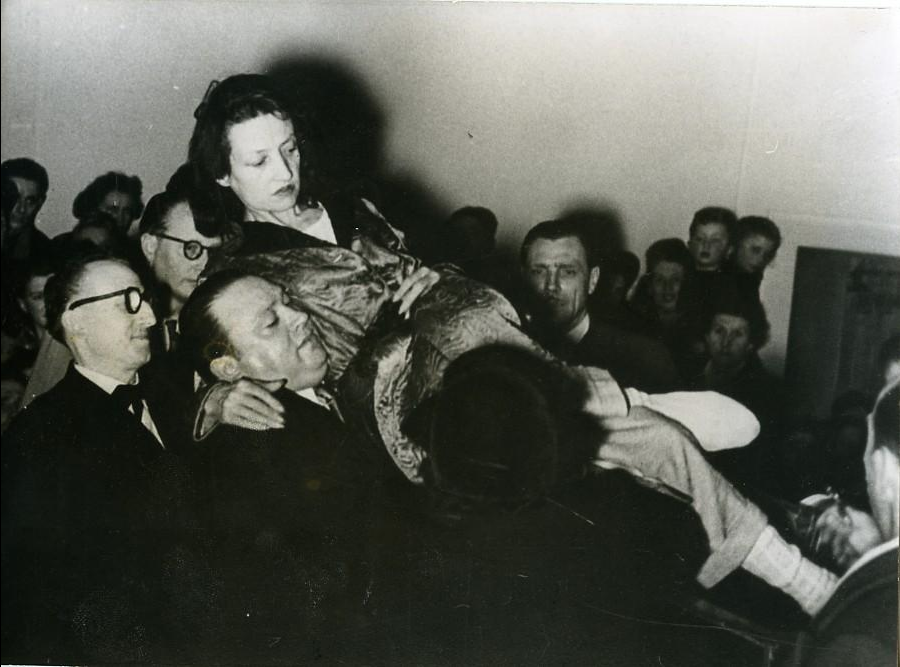
Photo source.
Posted By: Paul - Fri Mar 05, 2021 -
Comments (1)
Category: Food, Magic and Illusions and Sleight of Hand, Performance Art, 1950s, Europe, United Kingdom
Miss Cheesecake of 1951
Unlike many beauty queens, Franca Faldini did not hit a dead end with the assumption of her bogus title, but went on to have a decent career.
Source.
Posted By: Paul - Thu Mar 04, 2021 -
Comments (0)
Category: Beauty, Ugliness and Other Aesthetic Issues, Contests, Races and Other Competitions, Movies, 1950s, Europe
Follies of the Madmen #501
Our jockey shorts will have every male emulating a hula girl.Source.
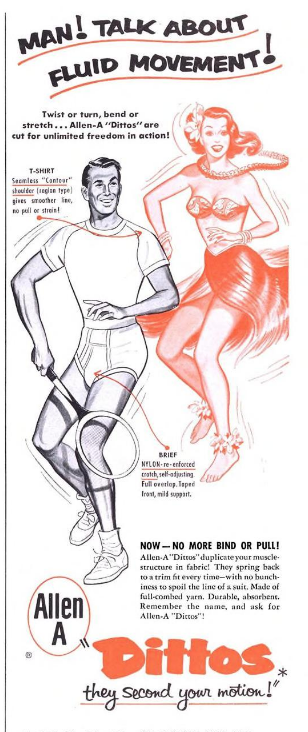 (Scroll down.)
(Scroll down.)
Posted By: Paul - Wed Mar 03, 2021 -
Comments (5)
Category: Business, Advertising, Underwear, 1950s, Gender-bending
Kirby’s Flying Ballet
This is the apparatus that famously caused Mary Martin to fly as Peter Pan.
Wikipedia page for Peter Foy.
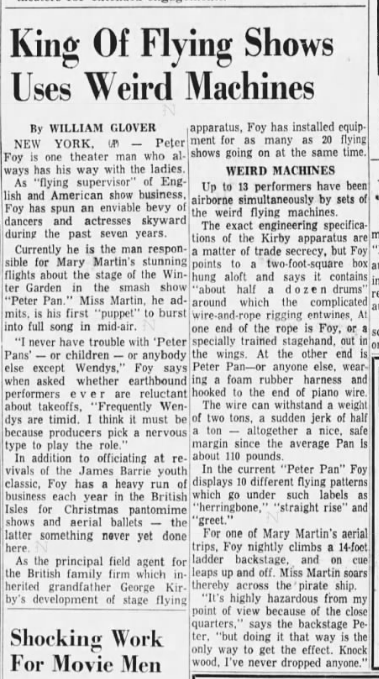
Posted By: Paul - Thu Feb 18, 2021 -
Comments (4)
Category: Technology, Theater and Stage, Special Effects, 1950s, 1960s
Follies of the Madmen #500
I suppose I should have come up with something super-special for the 500th installment of this series, but this will have to suffice!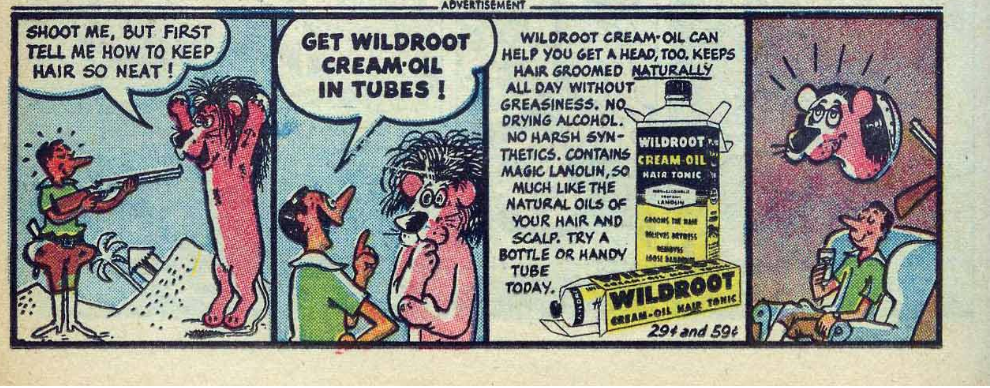
Sure, kill the talking lion and then...style his mane?
Posted By: Paul - Wed Feb 17, 2021 -
Comments (1)
Category: Animals, Business, Advertising, Death, Comics, 1950s, Hair and Hairstyling
Miss Welder
Between 1951 and 1954, the National Eutectic Welders' Club annually awarded the title of "Miss Welder". The winner was supposed to represent the "girl we would most like to weld with." The club also expressed its hope that Miss Welder would "inspire women throughout the nation to join the ranks of the labor force so vitally needed for America's defense effort."The winners included some well-known names. In particular, Sophia Loren (1954). Missing from the list below is Miss Welder of 1953, Barbara Nichols, for whom I couldn't find an image.
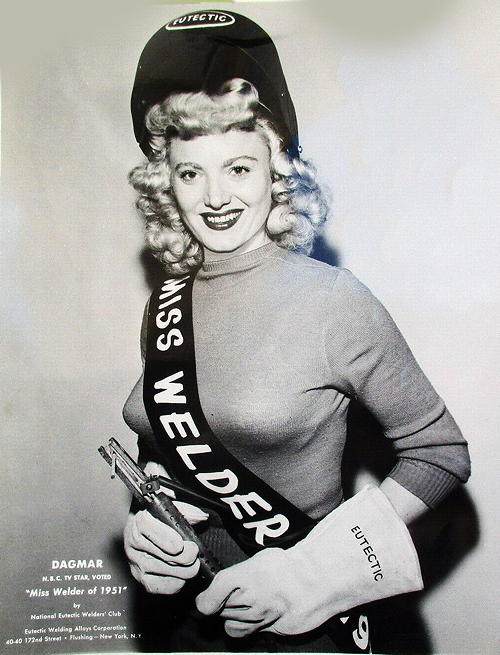
1951: Dagmar
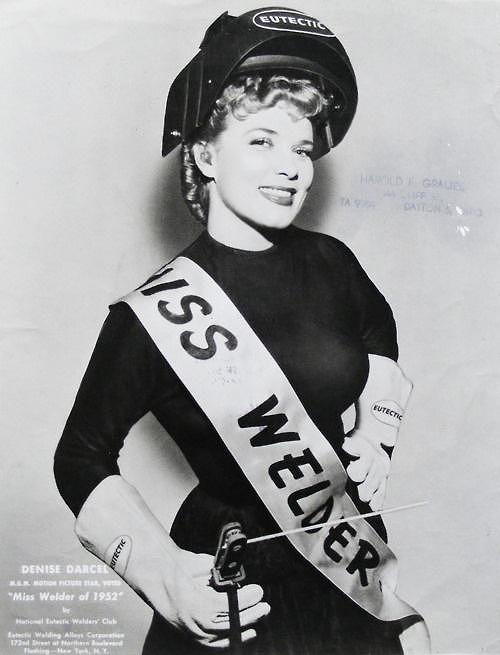
1952: Denise Darcel
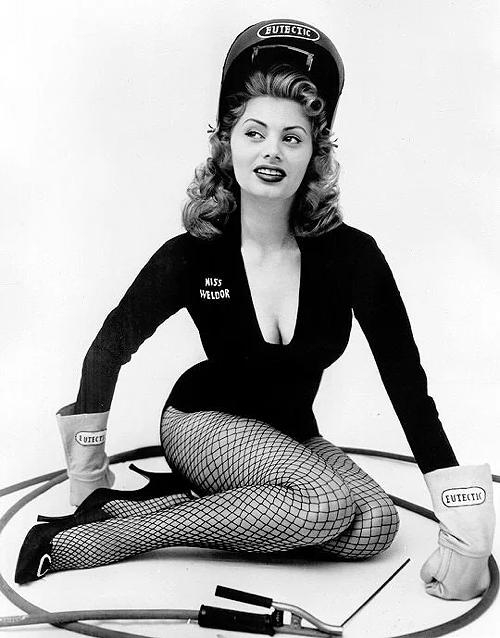
1954: Sophia Loren
Posted By: Alex - Fri Feb 12, 2021 -
Comments (2)
Category: Awards, Prizes, Competitions and Contests, Beauty, Ugliness and Other Aesthetic Issues, 1950s
American Look
Your head will be spinning with Midcentury Modern designs by the end of this film. A Utopia that never was.
Posted By: Paul - Wed Feb 03, 2021 -
Comments (1)
Category: Business, Design and Designers, Recreation, Interior Decorating, 1950s, Cars, Yesterday’s Tomorrows
Index of Boredom
In 1957, advertiser John P. Cunningham came up with the concept of an "Index of Boredom" in an attempt to quantify how bored TV viewers were while watching shows. His research team studied 160 viewers in New Brunswick, NJ, and concluded that the most boring show on TV was Milton Berle, while the least boring show was "I Remember Mama".But they also came across an unexpected finding: people would continue to watch TV shows even if they found them boring.

Deseret News - Oct 29, 1957
Posted By: Alex - Sun Jan 31, 2021 -
Comments (3)
Category: Boredom, Television, Psychology, 1950s

| Who We Are |
|---|
| Alex Boese Alex is the creator and curator of the Museum of Hoaxes. He's also the author of various weird, non-fiction, science-themed books such as Elephants on Acid and Psychedelic Apes. Paul Di Filippo Paul has been paid to put weird ideas into fictional form for over thirty years, in his career as a noted science fiction writer. He has recently begun blogging on many curious topics with three fellow writers at The Inferior 4+1. Contact Us |




